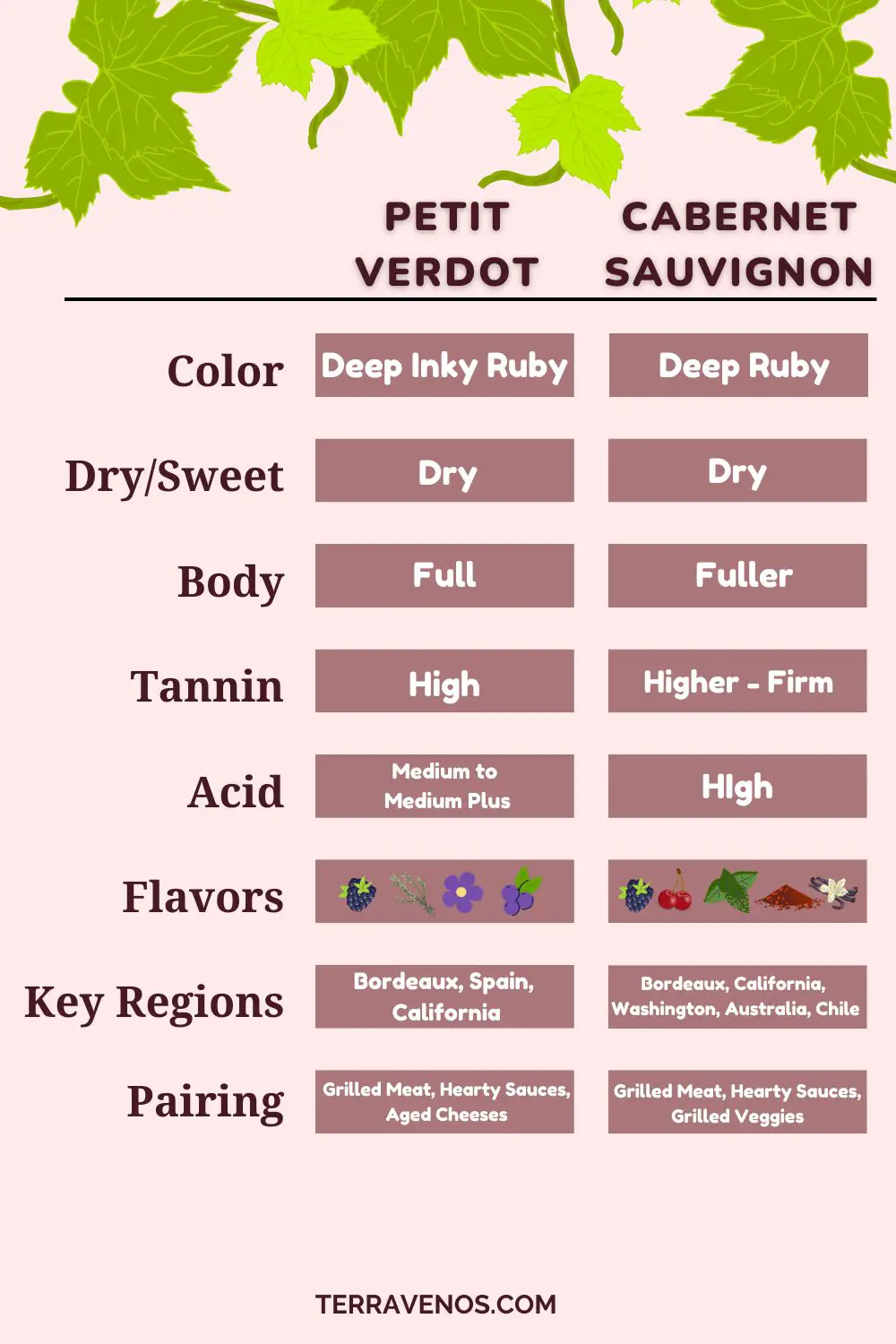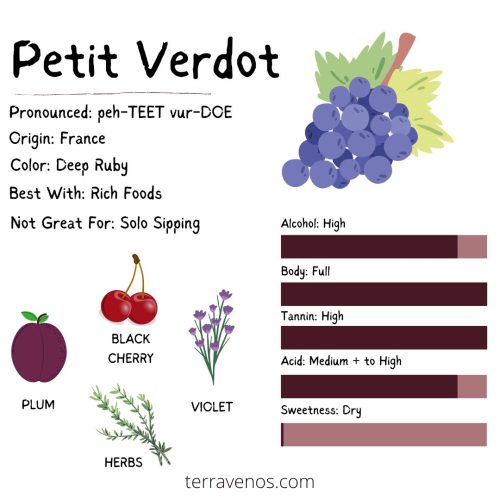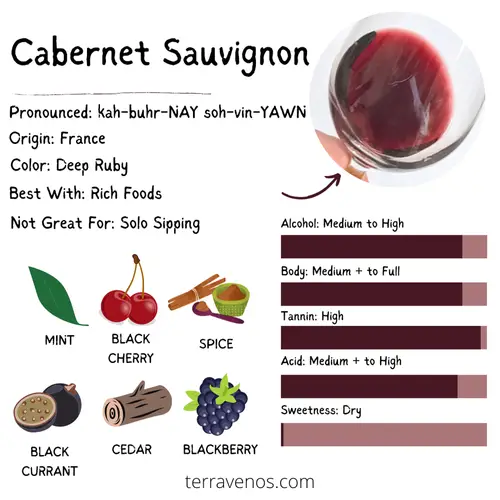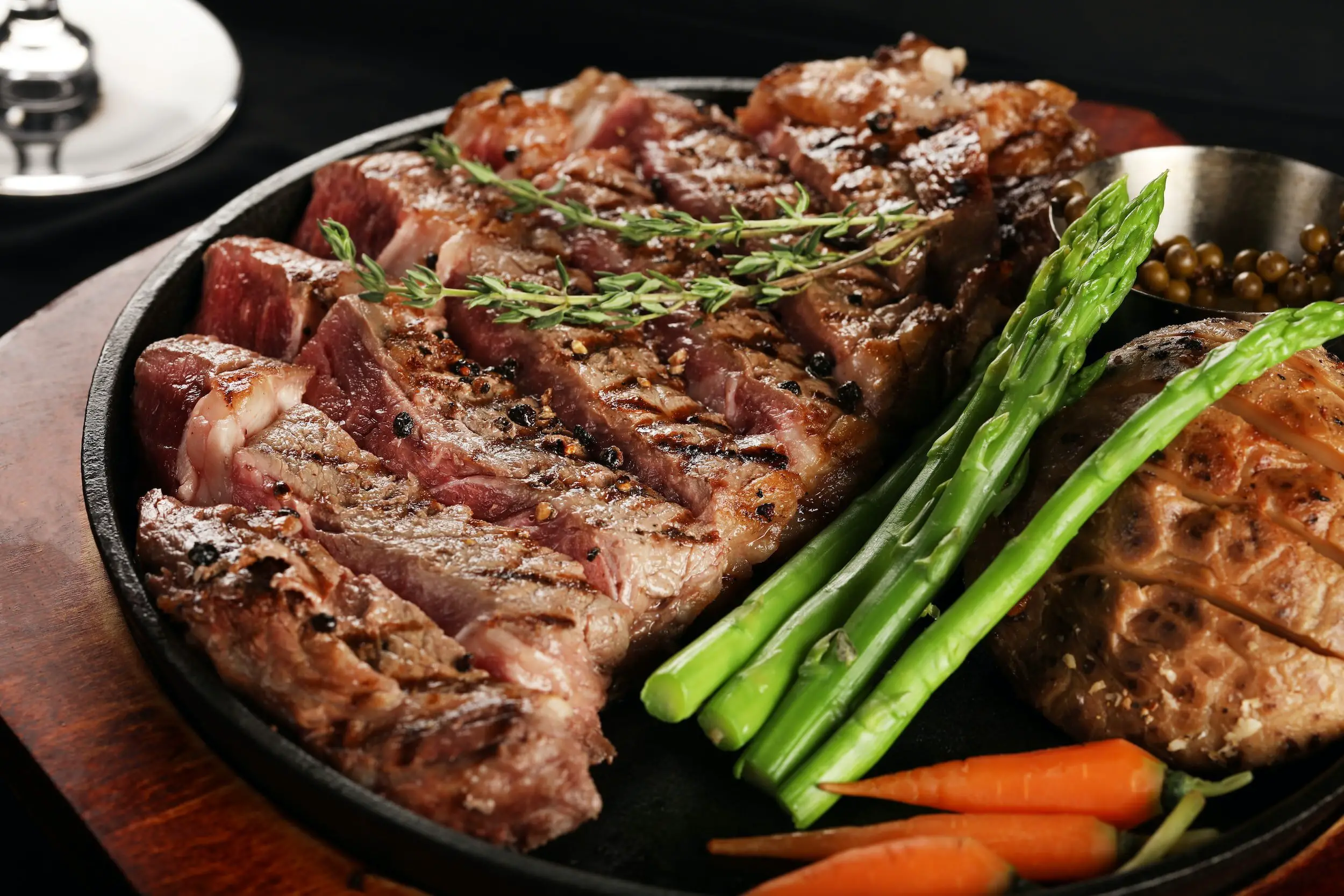
Petit Verdot vs Cabernet Sauvignon is a great wine comparison because these two wines are different, but often blended together.
Petit Verdot and Cabernet Sauvignon both have high tannins and a firm structure. Cabernet Sauvignon has a green note, and Petit Verdot has purple floral notes. Both are big wines.
TL;DR: If you enjoy Cabernet Sauvignon, you’ll most likely like Petit Verdot wines, too.
Here’s what you need to know about Petit Verdot vs Cabernet Sauvignon wines.
- Petit Verdot Basics: A Robust Blending Grape
- Cabernet Sauvignon Basics: King of Bordeaux
- Wine Comparison: Petit Verdot vs. Cabernet Sauvignon
- Petit Verdot vs Cabernet Sauvignon: Food Pairings and Serving Temperature
- Which Is More Expensive: Petit Verdot vs Cabernet Sauvignon?
- Which Is Better Petit Verdot or Cabernet Sauvignon?
- Final Thoughts – Petit Verdot or Cabernet Sauvignon?
- Thirsty for More?
Petit Verdot Basics: A Robust Blending Grape

Petit Verdot, originating from Bordeaux as well, provides a bold and robust experience. While historically used as a blending grape, Petit Verdot has gained recognition for its individual character.
Its flavor profile encompasses dark fruit, such as blackberry and plum, coupled with hints of spice and a touch of floral aromatics.
Fun Wine Fact: Petit Verdot, translating to “little green,” alludes to the late ripening of its small, thick-skinned berries.
Cabernet Sauvignon Basics: King of Bordeaux

Cabernet Sauvignon, originating from the Bordeaux region in France, has gained global recognition for its bold and full-bodied nature. It is known for its deep color, firm tannins, and complex flavor profile. Cabernet Sauvignon often exhibits notes of blackcurrant, blackberry, cedar, and hints of vanilla. It ages well and can develop more complexity over time. (Here’s a deep-dive into Cabernet Sauvignon wines.)
Fun Wine Fact: Cabernet Sauvignon is one of the main grapes that goes into Bordeaux wines; Petit Verdot is a minor blending grape in Bordeaux wines.
Wine Comparison: Petit Verdot vs. Cabernet Sauvignon
Here’s a quick side-by-side comparison of the most common styles of Petit Verdot and Cabernet Sauvignon wine.
| Characteristics | Petit Verdot | Cabernet Sauvignon |
|---|---|---|
| Hue | Deep purple to almost black | Deep red to purple |
| Color | Red | Red |
| Aromas | Dark fruit, violet, herbal | Blackcurrant, black cherry, mint, bell pepper, herbs |
| Tannins | High | High |
| Acid | Medium plus to high | Medium plus to high |
| Alcohol (%) | 14-15.5% | 13-15% |
| Body | Full | Full |
| Intensity | Medium plus to pronounced | Pronounced |
| Key Growing Regions | France (Bordeaux), Spain, California | France (Bordeaux), California, Australia, Chile |
| Classic Pairings | Grilled meats, game, hearty stews, aged cheeses | Steak, lamb, hard cheeses, rich dishes |
| Price Range | $20-$50 | $10-$100 |
Cabernet Sauvignon Wine Profile
- Sweetness: Cabernet Sauvignon wines are typically produced in a dry style, offering minimal residual sugar.
- Alcohol: Cabernet Sauvignon wines generally have a moderate to high alcohol content, ranging from around 13% to 15% ABV
- Body: Known for its full-bodied nature, Cabernet Sauvignon provides a rich and powerful drinking experience.
- Tannins: Cabernet Sauvignon wines often have firm tannins that contribute to their structure and aging potential.
- Acid: Cabernet Sauvignon has medium plus to high acid, similar to Petit Verdot wines.
- Flavors and Aromas: Cabernet Sauvignon exhibits intense flavors and aromas of black fruits, such as blackcurrant and blackberry, with underlying notes of cedar and vanilla.
Helpful Tip: Winemakers for both Petit Verdot and Cabernet Sauvignon often use oak during winemaking. Here’s what oak contributes to wine.
Petit Verdot Wine Profile
- Sweetness: Petit Verdot wines are dry.
- Alcohol: Petit Verdot wines typically have a higher alcohol content, ranging from around 14% to 15.5% ABV.
- Body: Petit Verdot is known for its full body and robust structure, similar to Cabernet Sauvignon.
- Acid: Petit Verdot has medium plus acid, about the same as Cabernet Sauvignon.
- Tannins: Petit Verdot showcases firm and gripping tannins, adding to its powerful and bold character.
- Flavors: The flavor profile often includes dark fruit notes like blackberry and plum, accompanied by hints of herbs and purple floral undertones.
Helpful Tip: Pop over to this 30-second tasting tip to learn how to taste wine tannins.
Are Petit Verdot and Cabernet Sauvignon Similar?
Both Petit Verdot and Cabernet Sauvignon wines are rich and full-bodied with dark fruit flavors. Both wines are often oaked, with mocha, coffee, and chocolate notes. They both have similar alcohol levels and high tannins. Both are used to make Bordeaux blends. Petit Verdot adds color, floral notes, and a middle-palate mouthfeel. Cabernet Sauvignon adds acid and rich dark red fruit and herbs.
What Is the Difference Between Petit Verdot and Cabernet Sauvignon?
Petit Verdot is deeper in color than Cabernet Sauvignon. Cabernet Sauvignon has a distinctive green note that it gets from the Sauvignon wine family (Sauvignon Blanc shares the same quality). Petit Verdot has lovely purple flower notes.
Petit Verdot vs Cabernet Sauvignon: Food Pairings and Serving Temperature

Petit Verdot and Cabernet Sauvignon Food Pairing: Both of these wines have strong tannins and robust bodies that need to be paired with protein- and fat-rich dishes. Grilled and roasted meats, vegetables and hearty stews are what you’re going to want to have with Cabernet Sauvignon and Petit Verdot.
Both Petit Verdot and Cabernet Sauvignon are best enjoyed at slightly below room temperature. Place them in a cool, dark place for a while before serving.
Discover More:
Red Wine and Cheese Pairing: What You Need to Know
Cabernet Sauvignon vs Cabernet Franc
Cabernet Sauvignon vs Merlot
Cabernet Sauvignon vs Malbec
Which Is More Expensive: Petit Verdot vs Cabernet Sauvignon?
Petit Verdot Cost
- Entry-level Petit Verdot wines are a little more expensive than entry-level Cab Sav, around $20 to $30 per bottle. These wines provide a robust and flavorful experience at a reasonable cost.
- On the premium side, Petit Verdot from boutique producers commands prices ranging from $35 to $50 or higher. However, these are more affordable than premium Cabernet Sauvignon.
Cabernet Sauvignon Cost
- Entry-level Cabernet Sauvignon wines are often priced between $10 and $20 per bottle, offering accessible options for everyday enjoyment.
- If you’re looking for premium selections from renowned producers or specific regions, prices can range from $30 to $100 or more.
Helpful Tip: Here’s how a bottle of wine gets priced. This post is a little nerdy, but it’s quite complicated and nuanced depending on where you are in the world and where you’re buying your wine.
Which Is Better Petit Verdot or Cabernet Sauvignon?
If you enjoy bold, robust red wine with tannin and floral undertones, then Petit Verdot is the better wine. If you prefer a full-bodied wine with a herbaceous bite and rich spice, then stick with Cabernet Sauvignon.
Final Thoughts – Petit Verdot or Cabernet Sauvignon?
Both Petit Verdot and Cabernet Sauvignon are big red wines that you should know about if you enjoy this wine style.
I’m a believer in side-by-side tastings to tease out the different wine characteristics. A great way to get started with these two wines is to do a side-by-side comparison.
Grab 2 bottles of similarly priced Petit Verdot and Cabernet Sauvignon. Invite over a few friends and enjoy an evening of swirling and sipping.
Helpful Tip: These are both food wines. Make sure you have something to eat along with them.
Thirsty for More?
I’m a big believer in doing side-by-side tastings to boost your wine knowledge. Here’s how to host your own wine tasting for beginners.
Check out this post on Cabernet Sauvignon vs Merlot, another popular red wine, along with Cabernet Sauvignon vs Malbec, and Shiraz vs Merlot.
You should be able to find delicious wines at every price point. Check out this post on how to find great wines under $50.



